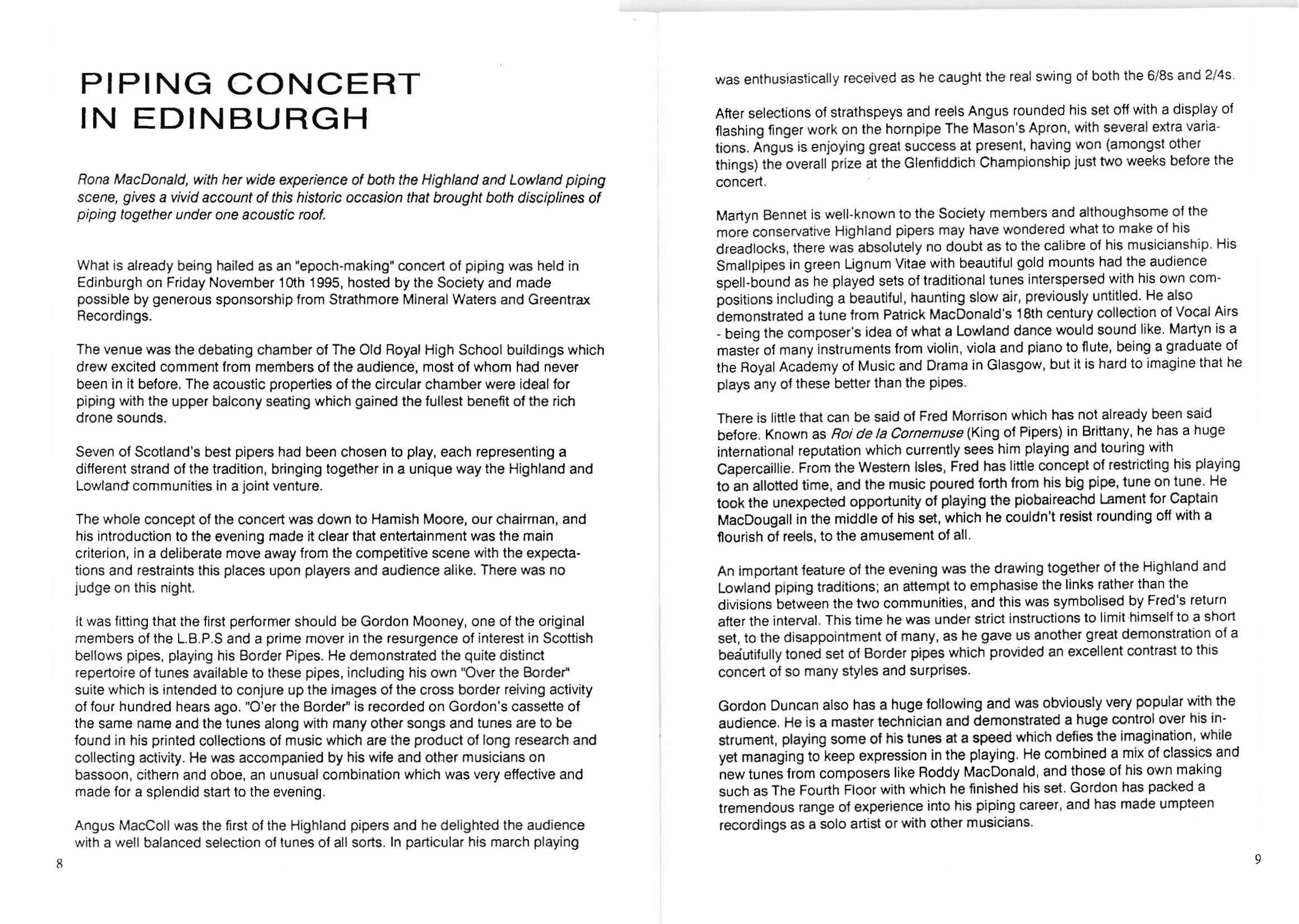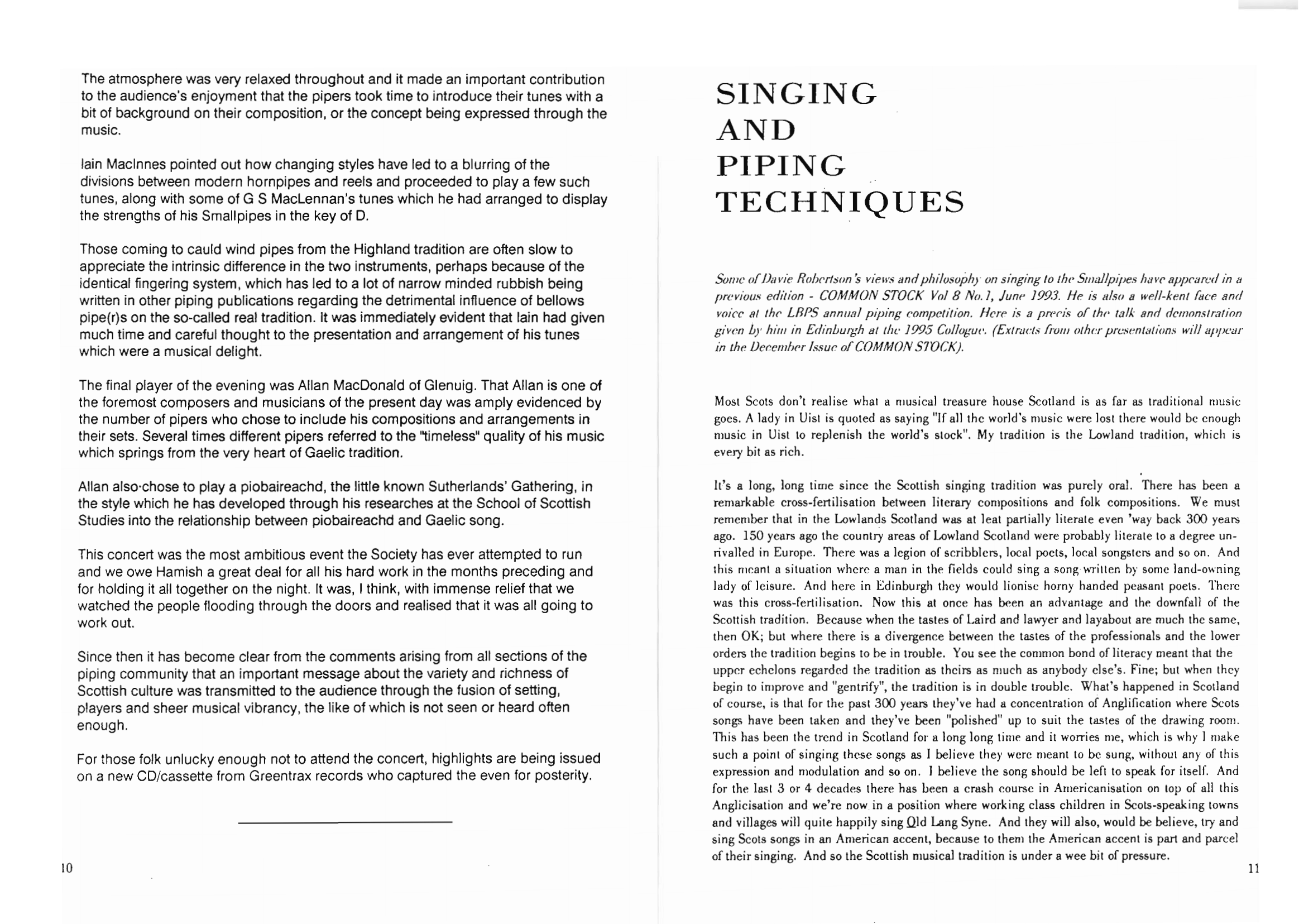Piping Concert in Edinburgh


Rona MacDonald, with her wide experience of both the Highland and Lowland piping scene, gives a vivid account of this historic occasion that brought both disciplines of piping together under one acoustic root.
What is already being hailed as an “epoch-making” concert of piping was held in Edinburgh on Friday November 10th 1995, hosted by the Society and made possible by generous sponsorship from Strathmore Mineral Waters and Greentrax Recordings.
The venue was the debating chamber of The Old Royal High School buildings which drew excited comment from members of the audience, most of whom had never been in it before. The acoustic properties of the circular chamber were ideal for piping with the upper balcony seating which gained the fullest benefit of the rich drone sounds.
Seven of Scotland’s best pipers had been chosen to play, each representing a different strand of the tradition, bringing together in a unique way the Highland and Lowland communities in a joint venture.
The whole concept of the concert was down to Hamish Moore, our chairman, and his introduction to the evening made it clear that entertainment was the main criterion, in a deliberate move away from the competitive scene with the expectations and restraints this places upon players and audience alike. There was no judge on this night.
It was fitting that the first performer should be Gordon Mooney, one of the original members of the L.B.P.S and a prime mover in the resurgence of interest in Scottish bellows pipes, playing his Border Pipes. He demonstrated the quite distinct repertoire of tunes available to these pipes, including his own “Over the Border” suite which is intended to conjure up the images of the cross border reiving activity of four hundred hears ago. “O'er the Border” is recorded on Gordon’s cassette of the same name and the tunes along with many other songs and tunes are to be found in his printed collections of music which are the product of long research and collecting activity. He was accompanied by his wife and other musicians on bassoon, cithern and oboe, an unusual combination which was very effective and made for a splendid start to the evening.
Angus MacColl was the first of the Highland pipers and he delighted the audience with a
well balanced selection of tunes of all sorts. In particular his march playing was enthusiastically received as he caught the real swing of both the 6/8s and 2/4s.
After selections of strathspeys and reels Angus rounded his set off with a display of flashing finger work on the hornpipe The Mason's Apron, with several extra variations.
Angus is enjoying great success at present, having won (amongst other things) the overall prize at the Glenfiddich Championship just two weeks before the concert.
Martyn Bennet is well-known to the Society members and although some of the more conservative Highland pipers may have wondered what to make of his dreadlocks, there was absolutely no doubt as to the calibre of his musicianship. His Smallpipes in green Lignum Vitae with beautiful gold mounts had the audience spell-bound as he played sets of traditional tunes interspersed with his own compositions including a beautiful, haunting slow air, previously untitled. He also demonstrated a tune from Patrick MacDonald's 18th century collection of Vocal Airs - being the composer's idea of what a Lowland dance would sound like. Martyn is a master of many instruments from violin, viola and piano to flute, being a graduate of the Royal Academy of Music and Drama in Glasgow, but it is hard to imagine that he plays any of these better than the pipes.
There is little that can be said of Fred Morrison which has not already been said before. Known as Roi de la Cornemuse (King of Pipers) in Brittany, he has a huge international reputation which currently sees him playing and touring with Capercaillie. From the Western isles, Fred has little concept of restricting his playing to an allotted time, and the music poured forth from his big pipe, tune on tune. He took the unexpected opportunity of playing the piobaireachd Lament for Captain MacDougall in the middle of his set, which he couldn't resist rounding off with a flourish of reels, to the amusement of all.
An important feature of the evening was the drawing together of the Highland and Lowland piping traditions; an attempt to emphasise the links rather than the divisions between the two communities, and this was symbolised by Fred’s return after the interval. This time he was under strict instructions to limit himself to a short set, to the disappointment of many, as he gave us another great demonstration of a beautifully toned set of Border pipes which provided an excellent contrast to this concert of so many styles and surprises.
Gordon Duncan also has a huge following and was obviously very popular with the audience. He is a master technician and demonstrated a huge control over his instrument, playing some of his tunes at a speed which defies the imagination, while yet managing to keep expression in the playing. He combined a mix of classics and new tunes from composers like Roddy MacDonald, and those of his own making such as The Fourth Floor with which he finished his set. Gordon has packed a tremendous range of experience into his piping career, and has made umpteen recordings as a solo artist or with other musicians. The atmosphere was very relaxed throughout and it made an important contribution to the audience's enjoyment that the pipers took time to introduce their tunes with a bit of background on their composition, or the concept being expressed through the music.
Iain MacInnes pointed out how changing styles have led to a blurring of the divisions between modern hornpipes and reels and proceeded to play a few such tunes, along with some of G S MacLennan’s tunes which he had arranged to display the strengths of his Smallpipes in the key of D.
Those coming to cauld wind pipes from the Highland tradition are often slow to appreciate the intrinsic difference in the two instruments, perhaps because of the identical fingering system, which has led to a lot of narrow minded rubbish being written in other piping publications regarding the detrimental influence of bellows pipe(r)s on the so-called real tradition. It was immediately evident that Iain had given much time and careful thought to the presentation and arrangement of his tunes which were a musical delight.
The final player of the evening was Allan MacDonald of Glenuig. That Allan is one of the foremost composers and musicians of the present day was amply evidenced by the number of pipers who chose to include his compositions and arrangements in their sets. Several times different pipers referred to the “timeless” quality of his music which springs from the very heart of Gaelic tradition.
Allan also-chose to play a piobaireachd, the little known Sutherlands’ Gathering, in the style which he has developed through his researches at the School of Scottish Studies into the relationship between piobaireachd and Gaelic song.
This concert was the most ambitious event the Society has ever attempted to run and we owe Hamish a great deal for all his hard work in the months preceding and for holding it all together on the night. It was, I think, with immense relief that we watched the people flooding through the doors and realised that it was all going to work out.
Since then it has become clear from the comments arising from all sections of the piping community that an important message about the variety and richness of Scottish culture was transmitted to the audience through the fusion of setting, players and sheer musical vibrancy, the like of which is not seen or heard often enough.
For those folk unlucky enough not to attend the concert, highlights are being issued on a new CD/cassette from Greentrax records who captured the event for posterity.
